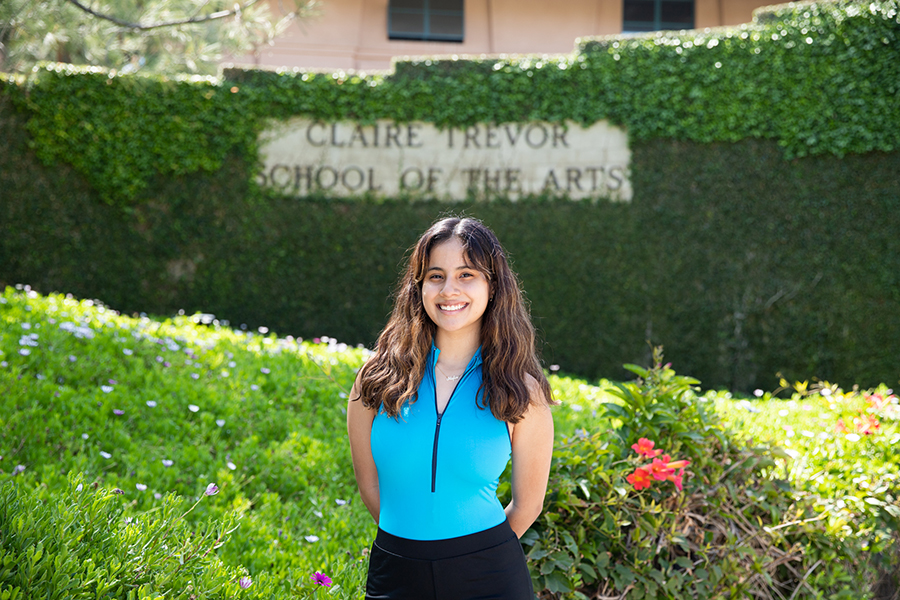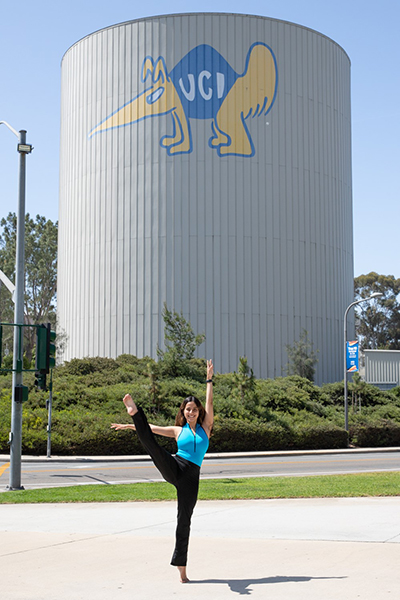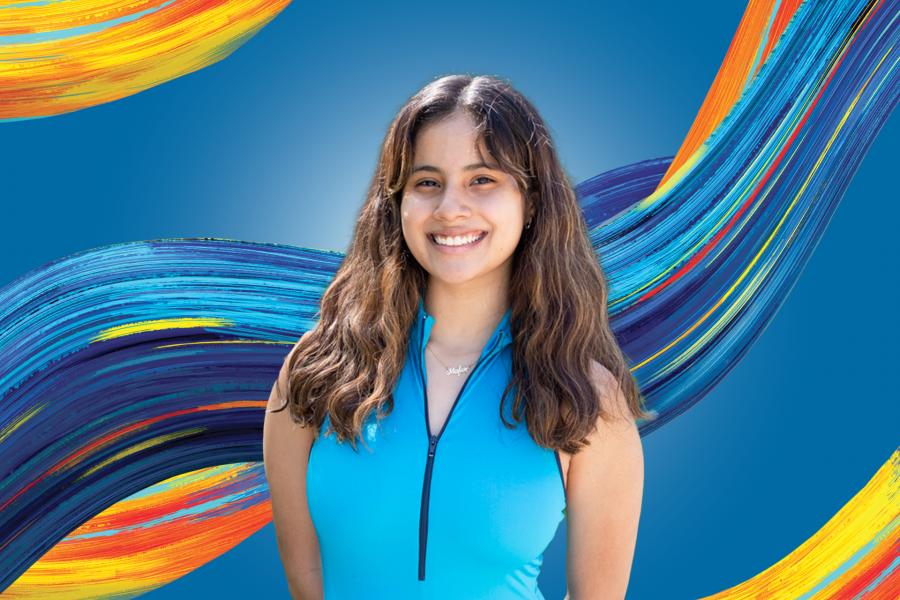Mafer Reyes: Dance-Educator-in-the-Making
By Mia Hammett
A second year undergrad, Mafer Reyes has managed to balance an ever-growing series of interrelated professional positions within and without the UCI campus. And she’s only just begun.
Ostensibly generous with her time and energy, Reyes dedicates herself wholeheartedly to her outside-of-school commitments. She divides her time between tutoring at a local high school, teaching dance classes at the K-12 level, and active membership in UCI Dance’s Community Student Advising Committee, a collaborative community of dance majors dedicated to “improv[ing] the community experience by promoting open communication within the dance department” –– the connective tissue between the school’s dance department and its undergraduate constituents.
Not to mention Reye’s full-time dance major status that, in and of itself, entails a balancing of arts and academic classes. Put lightly: it’s a whirlwind of responsibilities.

Image: Mafer Reyes stands in front of the Claire Trevor School of the Arts monument sign on Mesa Road. (Photo by Emily Zheng)
Reyes notes the relationship between her studies in both Dance and Business Administration –– two seemingly opposite points of academic pursuit.
“To become a good artist, you have to know how to manage your own business. It doesn’t have to be a business as a dance studio or dance classes, but as your career.” Business, Reyes explains, in the sense of building and maintaining the financial structures that may contribute to the trajectory of one’s own professional dance career.
According to Reyes, being a professional dancer is so much more than we’re led to believe. You have to dedicate your time and money to travel, booking, food, and training. On top of actually performing your work on-stage, you have to decide if your pay is fair. The thing is, Reyes says, “business is behind every artist, not just dancers –– and sometimes they don't know it.”
...business is behind every artist, not just dancers –– and sometimes they don't know it.
As an extension of her soon-to-be business expertise, Reyes hopes to one day manage her own dance studio. “I'm trying to pursue a B.A. in Business Administration because I want that studio –– I want to know how to properly run a business, how to make a business plan, how to present that to a bank and ask for a loan, and know a bit of accounting, too,” Reyes says.
With owning a studio, “It’s a lot of bookkeeping, hiring people, making the class, hiring costume [designers], and dancers themselves. But I like the business; I think it's something that's very general, that you can apply to other careers.” Confidently knowing the ins-and-outs of a business-oriented economy undoubtedly sets Reyes up for success.
And what’s more, there come the physical repercussions of back-to-back dance training. “As a college dance student, it has surprised me how it takes a lot of time… most of us dance majors, we take dance technique classes, three-to-four-to-five days per week –– so even though you’re not writing an essay, you have to be committed, and it's something that you put your body into, so you’re sore the whole day; and on top of that, you have your regular [academic] classes.”
As a UCI dance major, Reyes carries with her a key dance (and life) lesson: “In one of my choreography classes we were talking about uncertainty… and I think, as a dancer, sometimes you don't know if you're doing the right thing. But sometimes when you’re in that place of uncertainty, you come up with the best of your ideas –– because you're in that difficult moment and you push yourself to create something you're not used to. I think in any type of dance, teachers ask you to dance a certain way –– and of course you have to do it. But you also have to stay true to yourself, what you believe in, and your own style.”
...sometimes when you’re in that place of uncertainty, you come up with the best of your ideas.
Reyes builds her individual style through the accumulation of learned lessons –– be it a physical dance technique or a novel approach to learning.
With dance, “I think I got more serious about it when I was ten or eleven –– all of this is where I’m from, in Ecuador. I stayed there until I was fifteen, so my core training was over there.
I trained in ballet, mainly. It was Cuban-style. Then when I got here, I went to a ballet academy, and it was Russian-style. Dance has a lot of different techniques.”
Reyes attended Southland Dance Ballet Academy, a private school, for a year. After the money ran out, “my option was dance at my high school. So I started dancing on my dance team at Century High School.”
It’s that same Century High School where Reyes currently works as a tutor in their after-school program. “I mostly tutor math –– I also enjoy working with the Spanish-speaking students, because I once was in their spot.”
Transition to CC
 The CTSA’s Creative Connections program offers arts majors the opportunity to create and cultivate an arts curriculum for K-12 students “in collaboration with an Orange County area educator.” As part of the program, Reyes has earned the paid position of a Teaching Artist Intern, whose work further encourages Reyes’ active, hands-on approach to dance education –– in turn supporting Reyes’ own learning.
The CTSA’s Creative Connections program offers arts majors the opportunity to create and cultivate an arts curriculum for K-12 students “in collaboration with an Orange County area educator.” As part of the program, Reyes has earned the paid position of a Teaching Artist Intern, whose work further encourages Reyes’ active, hands-on approach to dance education –– in turn supporting Reyes’ own learning.
Reyes’ introduction to the program was wholly organic. “I learned about the program [by] looking through the CTSA website. I read their mission of working with educators around our community and working with students and it brought me curiosity –– because my goal is to teach after college; I’m trying to get more hands-on experience.”
As a result of her involvement with the program, Reyes feels she’s gained her most worthwhile experiences as a Teaching Artist Intern.
“I’ve taught two classes, and from those I think I’ve taken more as an experience for myself. I approach it as a college class but with high schoolers. I remember when I was in my high school’s dance team, we wouldn’t have class –– it was more like practice. With my internship, I’m approaching it more as bringing new concepts to them that maybe they're not too familiar with, and at the same time, those concepts are the ones I’m learning here. For example: the modern style, I didn’t really know anything until I got to college. I was more [into] ballet technique. It’s a lot of different things that you think about, like your spine, your head alignment in relation to gravity, tailbone placement –– a lot of different things I didn’t know about.”
Your head alignment in relationship to gravity, tailbone placement
“I’ve been gaining more knowledge by watching the teacher and how she interacts with the students. I’ve learned from the students and how creative they are with the resources that they have… I’ve learned that they can be so creative when they are in an environment that pushes them to be creative.”
Above all, her work with Santa Ana High School and Century High School has forced Reyes to recognize what she wants most out of a long-term dance career: community ties.
“It’s making me realize how much I want to work with my community. Also, as a Latina myself, I want students to feel represented; I want them to know that someone that looks like them can pursue an arts career.”
It’s important to Reyes to support the arts, an often overshadowed and undervalued part of her school’s core curriculum, in every way, shape, and form. As an immigrant, equal arts education opportunities for the underrepresented, too, feels maximally relevant to Reyes’ professional developments.
“There's not too [many] Latinas or immigrants as arts majors. In Santa Ana, it's a low-income community –– mainly Latinos –– and I know the arts there are not something that’s so supported by the government, so it would be wonderful if I could transfer all the knowledge I'm gaining here to younger kids. And when I was in their position, I wish someone could have been there for me to tell me what to expect in college, especially as a dance major.”
“Why did I pick UCI? Because it was destiny,” she casually admits. “When I moved here, I went to the ballet academy. They would have performances in the Barclay Theatre, and I didn’t know it was a university because I just got here.”
“Then, in the summer before my senior year, a dance teacher told me [about] this program at UCI –– a program for high-schoolers where they have training at college level. She saw my potential my junior year. “You should go,” she told me. “I’ll pay half of it.” I fell in love with UCI when I came to the program. So it just felt right.”
The program in question is part of UCI’s Summer Academies in the Arts –– “college and career preparatory intensives in Art, Dance, Drama and Music focused on practical and technical skill development for experienced high school and transfer arts students on campus at UC Irvine.” It was through this summer program that Reyes’ relationship with UCI bloomed.
Reyes answers the age-old question: Why do you dance?
“I dance because it's art. Because I like the process behind it. I do like performing –– but if you ask me what I like more, it’s the late-night practices, rehearsing with twenty other people, having a collaboration between students, teachers and myself” –– the “behind-the-scenes” of it all, Reyes beams.
Image (above): Reyes poses in front of the UCI water tower next to the Bren Center on campus. (Photo by Emily Zheng)
Join us on a journey of discovery leading up to #UCIGivingDay 2022 on May 18, as we highlight current faculty and students at CTSA and learn more about what the pandemic has taught them about adaptability and innovation as we emerge brighter! Follow us on social media @ctsa_ucirvine.
Mia Hammett is a second-year English major in the School of Humanities.

